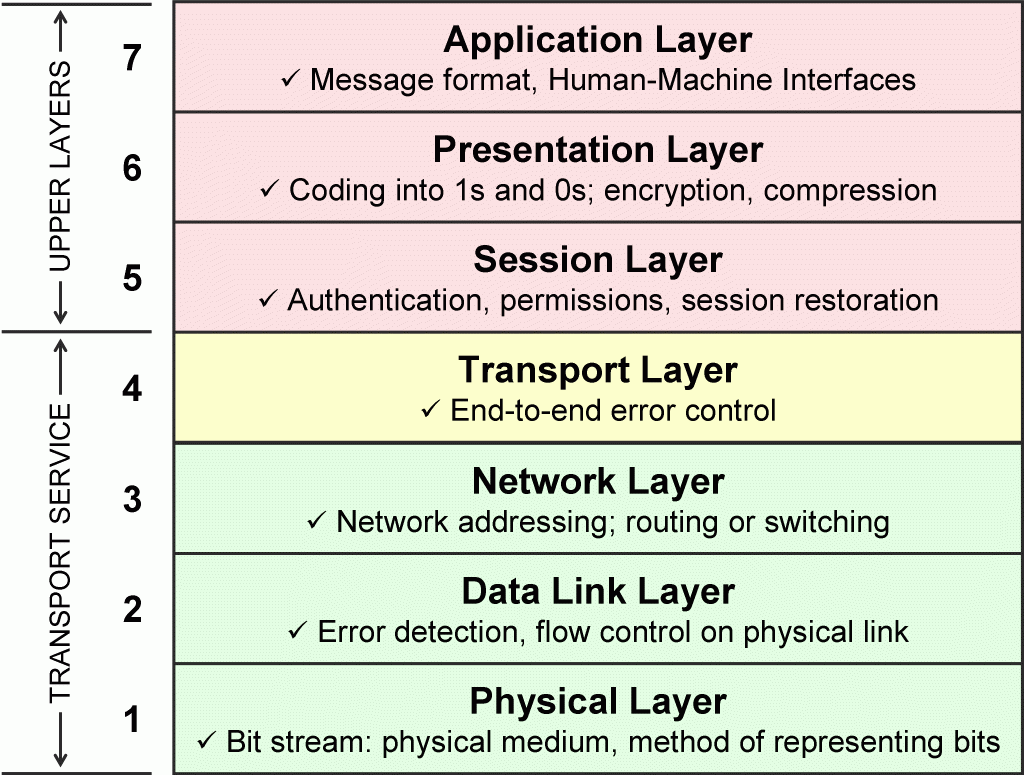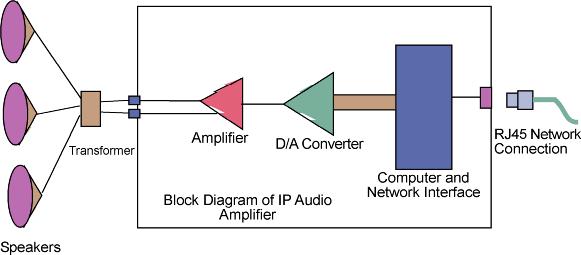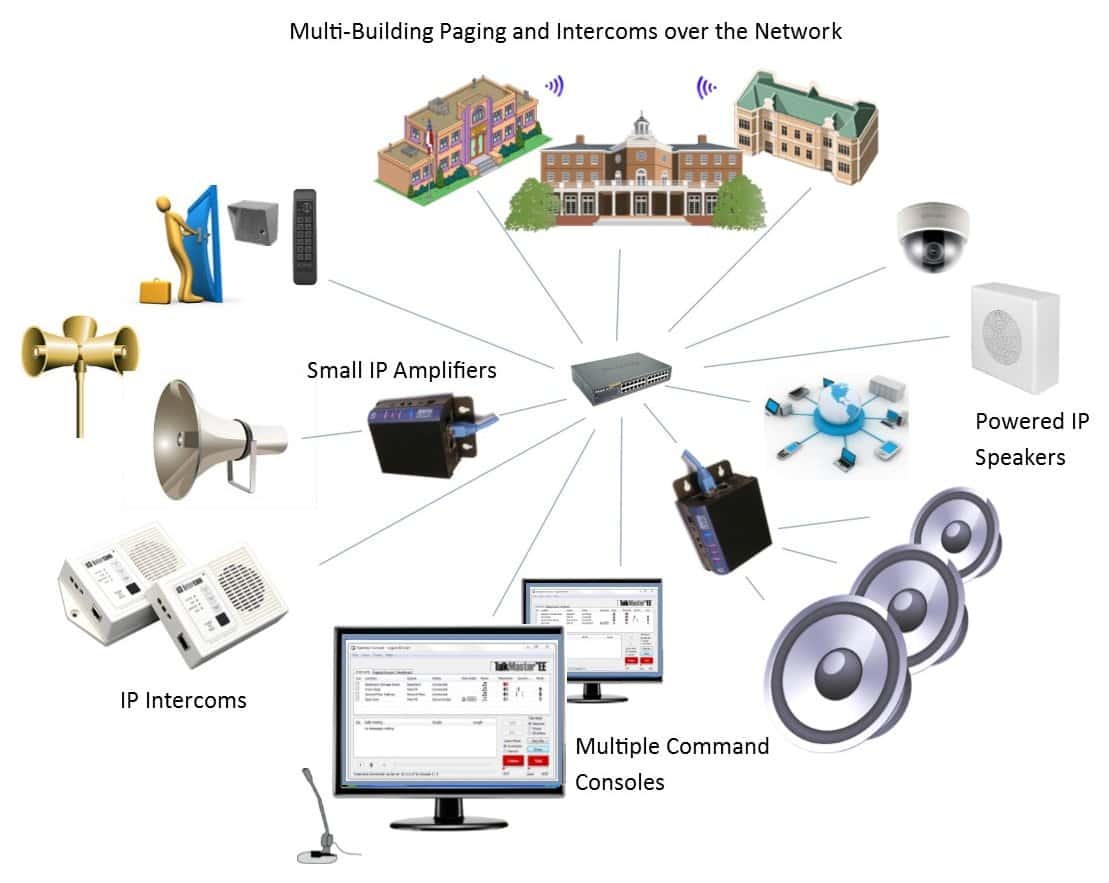
How do the latest network-attached IP audio systems work? The latest digital IP systems use protocols that are similar to Voice over IP (VoIP) protocols. This communication method also uses Power over Ethernet (PoE) to power the telephones, IP paging systems, and IP intercoms.
These IP audio systems use the network cable rather than using individual wires that go from an amplifier to a speaker. What is the magic behind sending multiple paging announcements on the same wire at virtually the same time?
Arthur C. Clark said, “Any sufficiently advanced technology is indistinguishable from magic.”
Here’s how the magic works.
Communication Concepts for IP Intercoms and Other Network Devices
Before we get into the specific way that network paging, intercoms and phones work, here’s a review of how information is transported over the network. Everything is digital or in a binary form. This means that information such as video, images, or sound is converted from an analog signal to a digital signal that is coded in binary. It’s the same concept that I described in my article “How does the Computer Work”.
To transfer information from one computer to another, on a network, we use a protocol. A protocol is the detailed set of commands or rules that control how information is sent from one device to another on the network. Here is a simple example of a network protocol:
Device-147: Hey you!
Device-135: Who me?
Device-147: Yeah, you at address 135. (Establishing the address of the device to talk to)
Device-135: What?
Device-147: How are you doing? (Getting status)
Device-135: Fine.
Device-135: Who are you?
Device-147: I’m the computer at 147 (Establishing a connection)
Device-147: I plan to send you some data.
Device-135: OK, what kind of data?
Device-147: Some analog sound.
Device-135: What format?
Device-147: I’ll use SIP using G.711 compression
Device-135: OK
Device-147: I’m sending 25 packets (sending the sound files)
Device-135: Thanks I received 25 packets (checking for errors)
Device-147: Any errors?
Device-135: Nope. Looks good.
Device-147: Thanks. Goodbye. (Disconnect)
The messages on the network go back and forth very fast so that many different messages with payloads such as video or audio can be sent to many different devices at virtually the same time. Of course, the more devices and the more messages we place on the network, the more bandwidth we use, but in most cases, it works very well. The video takes up the most bandwidth (about 2,500 Kbps). Audio takes relatively small amounts of bandwidth (about 65 Kbps) so we can make many different announcements on the paging system, or have many conversations between phones on the network.

Protocols used in VoIP
When we move audio packets across the network, we are mostly concerned with the session and transport-level of the network layers. Note that the levels are described differently depending on if we use the OSI model or TCP/IP Internet model.
I’m not going to get into this here, but just understand that there are different protocols that have responsibly to provide specific functions.
The most popular VoIP protocol is Session Initiated Protocol (SIP). This is a peer to peer type application layer of a TCP/IP network. SIP works with other application-level protocols such as Real-Time Transport Protocol (RTP). SIP is responsible for signaling and session management. It controls the end to end connection of a call between computer type devices (like VoIP phones or IP intercoms). Here are more details about how devices that use the SIP protocol work.
SIP devices or agents can be one of the following.
- A user agent client (UAC). This is a client application that initiates the SIP request
- A User agent server (UAS). A server application that contacts the user when a SIP request is received and the connection is established.
A device can take on the role of a client or server during a specific transaction.
SIP uses a unique address that is similar to an e-mail address. For example, addresses can be in the form of “[email protected].” When a device (user) initiates a call, a SIP request is sent to a SIP server (which can be a proxy or redirect server). Just like an e-mail message, the request includes the address of the caller as well as the address of the intended phone it is going to.
Once the connection is established, the digitized and compressed audio payload is sent back and forth between the two devices using RTP. This same Presentation protocol is used to transport not only audio but also other media such as video. Video is compressed using MPEG-4 or H.264. Audio is compressed using schemes such as G.711, G.723, G.726, G.729, GSM, QCELP, MP3, and DTMF. It is important to make sure that both sides of any communication protocol support all the commands and compression schemes used.
How Digital Paging and Intercom Devices Work

Here is an example of an IP amplifier. The IP7-SS40 digital IP amplifier is a device that connects to the network and uses some of the same protocols as a VoIP phone. It contains a special purpose computer and firmware that allows it to understand the protocols used to transport the compressed audio. It also contains a digital to analog converter and amplifier so it can drive a speaker. This IP amplifier connects to a Windows computer running special software called Talkmaster. Many IP7 amplifiers can connect to this central command computer at the same time.
The IP amplifier and intercom devices can use SIP to connect to other computer devices or VoIP phones, and it can also use a different protocol to establish a connection with the central computer. For example, to assure a constant connection between the IP7-SS40 amplifier and the central Windows computer, the IP address of the Windows computer is entered into the IP7 amplifier’s memory. The IP amplifier contacts the central server periodically to let the server know where it is located on the network, and that it is ready to receive an audio page. It also has a list of 3 other computer servers in its memory, so if the first computer is unavailable it will try to contact the next one on the list. This makes the system more redundant and reliable.
The Complete IP Intercom and Paging System

The complete system includes a Windows computer with an attached microphone, and Command Console software (Talkmaster). When a person talks into the microphone the audio is digitized by the computer system, and the software sends the audio packets to the right amplifier on the network. The amplifier is identified by its IP address. Talkmaster software can be used to talk to one or many different IP amplifiers at the same time.
Intercoms work in a very similar way. In this case, a connection is established between the intercom and the central computer. The intercom has a microphone as well as a speaker, so you can have a two-way conversation with the person at the computer.
IP Intercoms and Paging Summary
Computers and network-attached IP amplifiers and intercoms are all connected to the local area network. Audio can be sent over the network so that many different audio announcements can be sent at virtually the same time. These audio systems use special protocols to assure that the audio is sent to the right place and that the sound is clear and understandable. Using the network infrastructure makes these systems very easy to install and maintain. They provide the flexibility that wasn’t available with the older analog paging systems. Now you can make emergency paging announcements across a campus to many buildings at the same time. It’s a new world out there. One that has made the magic into a science that everyone can take advantage of.
If you need help sorting out the magic from the science please contact us at 1-800-431-1658 (in the USA), 914-944-3425 everywhere else, or use our contact form.